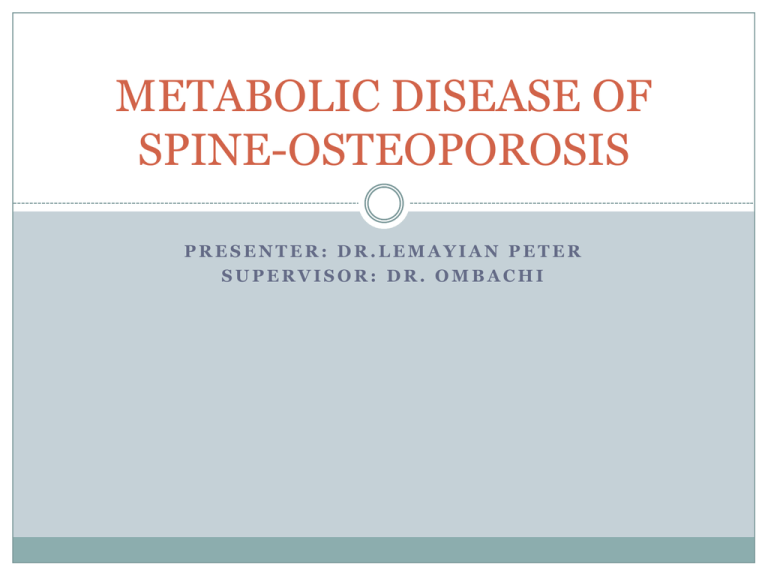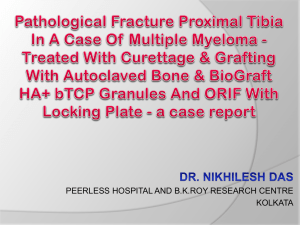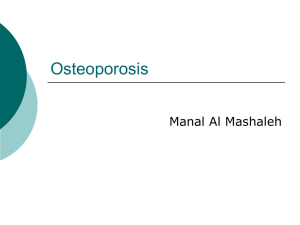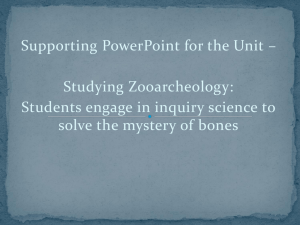
METABOLIC DISEASE OF
SPINE-OSTEOPOROSIS
PRESENTER: DR.LEMAYIAN PETER
SUPERVISOR: DR. OMBACHI
Skeletal d’se characterised by:
Low bone mass
Micro-achitectural breakdown of bone tissue
“silent killer”
Preventable d’se
Devastating physical, psychosocial and economical
consequence
Increasingly becoming a global problem-most
common metabolic bone d’se afflicting approx.
200m worldwide.
WHO DEFINITION:
DEFINITION
BMD
MEASUREMENT
T-SCORE
NORMAL
Within 1SD of mean BMD T-score >-1
for young adult women
OSTEOPAENIA
BMD 1-2.5 SD below the
mean for young adult
women
T-Score btn -1 and -2.5
OSTEOPOROSIS
BMD >2.5 SD below
mean for young adult
women
T-Score <-2.5
SEVERE
OSTEOPOROSIS
BMD >2.5 SD below
mean for young adult
women in a patient who
has already experienced
>1 fractures
T-Score <-2.5 with
fragility fractures
This definition applies to postmenopausal women
and men >50yrs
T-Score= patient’s BMD
BMD of control subjects who are at their
peak BMD
Z-Score=patient’s BMD
BMD of patients matched for age and sex
Z-Scores used in premenopausal women, children
and men<50yrs
PATHOPHYSIOLOGY
HALLMARK: reduced skeletal mass due to
imbalance btn bone resorption and
formation
Failure to build bone reserve from childhood
Bone loss
Aging with loss of gonadal function
Bone loss accelerates rapidly in women during the
first years after menopause
a) Estrogen deficiency leads to…
↑ expression of RANKL by osteoblasts
↓ release of OPG
↑recruitment of pre-osteoclasts→↑differentiation
and prolonged survival of osteoclasts via IL-1,IL6,TNFᾳ.
T-Cells inhibit osteoblastic differentiation and
activity with premature apoptosis of osteoblasts
through cytokines e.g. IL-7
Increased sensitization of bone to the effects of
PTH
↑osteoclastic apoptotic activity via ↑production of
TGFᵝ
b) Aging
Progressive ↓ in supply of osteoblasts
Reduced Ca2+ uptake from GIT
Bone resorption exceeds bone formation from 3rd
decade
Women lose-30-40% of cortical bone
-50% of trabecular bone
Men lose-15-20% of cortical bone
-25-30% of trabecular bone
c) Ca²⁺deficiency
→2° hyperPTH -↓ renal excretion of Ca2+
-↑ renal production of 1,25-(OH)2-D
(calcitriol)→↑ca2+ absorption from the gut
→↑bone resorption
d) Vit D Deficiency
Impaired absorption of Ca2+ from gut
Compensatory mechanism:-Leads to
hyperPTH→↑production of calcitriol from the
kidneys
PTH and vit.D have their effect on bone being
mediated via binding to osteoblasts and stimulating
RANK/RANKL pathway
Osteoclasts do not have receptors for Vit.D or PTH
Osteoporotic Fractures
Aka Insufficiency/ fragility fractures
Mostly from low-energy trauma/minor loads
Vertebral bodies-1rly cancellous with interconnected
horizontal and vertical trabeculae.
In osteoporosis there’s ↓ in both bone mass and
this internal interconnectivity(BUT
preferentially disruption is in the horizontal
trabeculae)→? Reason→?overaggresive osteoclastic
resorption
Rosen and Tenenhouse cadaveric study:
As many as 200-450 horizontal trabeculae fractures
per vertebral body in various stages of
healing→cumulatively leads to weakening of
cancellous bony structure
Osteoporosis Vs Osteomalacia
Normal human skeleton→60% mineral
40% organic material (collagen)
Osteoporosis-mineral: collagen ratio within normal
tho’ both are significantly ↓; bone is porous and
brittle
Osteomalacia-mineral is reduced relative to organic
content; bone is soft.
Classification of osteoporosis:
Localised
1°
Generalised
2°
1° Osteoporosis
(A) JUVENILE
Children/young adults; both sexes
8-14 yrs
Normal gonadal function
Hallmark: abrupt bone pain/ fracture following
minor trauma
(B) IDIOPATHIC
a) PMO(TYPE 1)-high-turnover osteoporosis
Women>50-65yrs
Phase of accelerated bone loss primarily
trabecular bone
Predorminantly increased osteoclastic activity
Fracture vertebrae and distal forearm common
Vertebral # occur more often in the 7th decade of
life.
b) age-related/senile osteoporosis(TYPE 2)
-Low-turnover osteoporosis
-gradual slow down in osteoblastic activity.
Men and women >70 yrs
Fractures in cortical and trabecular bone
Wrist, vertebrae and hip fractures common
2° Osteoporosis
CAUSE
EXAMPLES
GENETIC/CONGENITAL
Renal hypercalciuria, cystic fibrosis,
ehler’s danlos, gauchers, marfans
sx,osteogenesis imperfecta, hypoPO4²
ENDOCRINOPATHIES
Cushing’s sx, DM,adrenal insuff.,
prolactinomas, hyperthyroidism,
hyper-PTH, Hypogonadism,
panhypopituitarism, klinefelter’s,
turner’s sx
DEFICIENCY STATES
Ca2+, Mg2+, Vit. D def, protein def.,
celiac d’se, malabsorption,
malnutrition, parenteral nutrition
INFLAMMATORY CONDITIONS
IBD, R.A., SLE, Ankylosing spondylitis
HAEMATOLOGICAL/ NEOPLASTIC
DISORDERS
Haemophilia,, haemochromatosis,
leukaemia, lymphoma, multiple
myeloma, SCD, Thalassaemia,
metastases
MEDICATIONS
Anticonvulsants(Rx-induced Vit D
def), antipsychotics, ARVS,
Aromatase
inhibitors(Anastrozole),
anticancer drugs, Frusemide,
Glucorcoticoids( PDN>5mg OD
for >3/12), longterm Heparin, Li,
SSRI, Hormonal therapiesThyroxine, LHRH analogues
MISCELLANEOUS
Pregnancy, lactation, alcoholism,
depression, HIV/AIDS, CRD, CCF,
Chronic liver disease, amyloidosis,
prolonged immobility/disuse, Multiple
sclerosis
STAGES
STAGE 1: loss of horizontal trabeculations
STAGE 2: loss of vertical trabeculae
STAGE 3: loss of both horizontal and vertical
trabeculae with resultant cavitation of the vertebral
body
RISK FACTORS
National Osteoporosis Foundation (NOF) classifies
them into:
a) Modifiable:
physical inactivity
drugs, alcohol, cigarette smoking
deficiency states
Thin build/small stature(body wght <127lbs/
BMI<20-25 kg/m² in men),
>10% body weight loss in men
Androgen deprivation therapy in men
Previous fragility fracture
b) Non-modifiable:
age (>50yrs)
sex(F:M=4:1)
race(caucasian/asian)
genetics(+ve family history)
amenorrhoea, late menarche, early menopause
post-hysterectomy and oophorectomy,
androgen/ estrogen def.
Pneumonic=OSTEOPOROSIS
O=lOw ca2+
S=Seizure drugs
T=Thin build
E=Ethanol intake
O=hypOgonadism
P=Previous fracture
0=thyrOid excess
R=Race
O=Other realtives with osteoporosis
S=Steroids
I=Inactivity
S=Smoking
EPIDEMIOLOGY
10m Americans affected(80% women)-NOF
34M have ↓ bone mass with ↑ risk for osteoporosis
1.5m-2m osteoporotic fractures/yr (700,000 spinal
#; 300,000 hip #; 200,000 wrist #)
1 in every 2 women and 1 in every 5 men will
eventually experience osteoporotic #
Men have a higher prevalence of 2° osteoporosis
RACIAL DEMOGRAPHICS
RACE
SEX(AGE>50YR % ESTIMATED
S)
TO HAVE
OSTEOPOROSI
S
% ESTIMATED
TO HAVE LOW
BONE MASS
NON-HISPANIC
WHITE;ASIAN
WOMEN
20
52
MEN
7
35
WOMEN
5
MEN
4
19
WOMEN
10
49
MEN
3
23
NON-HISPANIC
BLACK
HISPANIC
Osteoporosis-related fractures result in annual direct
expenditure of $12.2b-17.9b
Leading cause of fractures in the elderly
Women>50yrs have about 50% lifetime fracture rate
due to osteoporosis and about 80% of all fractures in
pple aged >50yrs.
prognosis
Good if bone loss is detected early
Incase of #→ may lead to chronic pain, disability,
prolonged immobilisation, death
Vertebral compression fractures
2/3 are asymptomatic and occur slowly
Associated with ↑morbidity and mortality
Mortality also correlates with number of vertebral #
Often occurs with minimal stress
Mostly affected-middle/lower thoracic and upper
lumbar
As posture worsens and kyphosis
progresses→difficulty with balance, back pains, resp.
compromise,↑ risk of pneumonia
↓ QOL
Presence of a # at one vertebral level→5-fold ↑ risk
of getting another
CLINICAL PRESENTATIONS
Episode of acute back pain after bending,
coughing,lifting, a fall, minor trauma
Pain-sharp, nugging, dull; exacerbated by movt; may
radiate to the abdomen
Progressive kyphosis with loss of height
+/- localised pain
Paravertebral muscle spasm exacerbated by activity/
reduced by lying supine.
Complications:
Chronic pain
↑morbidity and mortality
↓ QOL
Prolonged immobility
Severe kyphosis
Spinal deformities→”dowager’s hump”→loss of 1-2’
of height by 7th decade of life
Loss of self-esteem→depression
PHYSICAL EXAM
Inspection
Palpation
Height measurement
Active/passive ROM
Neurological exam
Signs esp in the elderly that may indicate ↑risk of a
fall-gait problems, orthostatic hypotn, LL
weakness, cognitive impairment
Findings of subtle collagen defects:-short 5th digit,
dentinogenesis imperfecta, hyperlaxity, hearing
loss, pes planus, bunions, blue sclera
DDX
Osteomalacia
Tumors(osteolytic)
Infections
Osteonecrosis
Other bone-softening metabolic disorders
Mets
Leukaemia/lymphoma
Osteogenesis imperfecta
Renal osteodystrophy
Multiple myeloma
Scurvy
Paget’s disease
Sickle cell anaemia
Homocystinuria/homocystinaemia
WHO-Fracture-Risk algorithm(FRAX)
Developed to calculate 10yr probability of any major
osteoporotic # in a given patient
Take into a/c BMD and other clinical risk fxtrs
NOF recommends RX for patients with WHO-10yrprobability of major osteoporosis-related # of >20%
(or >30% for hip #)
This algorithm is useful in identifying patients most
likely to benefit from Rx.
SCREENING
Women >50yrs of age
For men, not carried out routinely
US preventive Services Task Force(USPSTF)/
American College of Physicians(ACP)
recommendations:
Indications for screening in men
Those with 10yr risk for osteoporotic # equal to or
greater than that for 65yr old women who have no
additional risk factors
INVESTIGATIONS
LAB WORKUP
a) To establish baseline conditions:
-CBC
-Serum Ca²⁺,mg²⁺,po4-,Fe2+/ferritin levels
-LFTs
-TFTs
-Vit. D levels
-Cr/BUN
i)
b) To exclude 2° causes
24 hr-urinary Ca2+ levels
PTH level
Testosterone/gonadotropin level
ESR/ CRP
Urinary free cortisol levels/ dexamethasone
suppression test
BMA
Serum/Urinary protein electrophoresis
ii) Biochemical markers of bone turnover
Reflect bone formation and resorption
Maybe ↑in high-bone turnover states and may also
be useful in some patients for monitoring early
response to treatment
SERUM MARKERS OF BONE FORMATION
Bone specific alkaline phosphatase(BSAP)
Osteocalcin(OC)-if high, indicates a high turnover
osteoporosis
Carboxyterminal propeptide of type 1 collagen(PICP)
Aminoterminal propeptide of type 1 collagen(PINP)
SERUM MARKERS OF BONE RESORPTION
Cross-linked C-Telopeptide of type 1 collagen(ICTP)
Tartrate-resisitant acid phosphatase
N-Telopeptide of collagen cross-links(NTx)
C-telopeptide of collagen cross-links(CTx)
URINARY MARKERS OF BONE RESORPTION
Hydroxyproline
Free and total pyridinolines(Pyd)
Free and total deoxypyridinolines(Dpd)
NTx
CTx
iii) IMAGING
(a) Plain radiography
-to assess overall skeletal intergrity
-suspected #
-if patient has lost>1½” of height
Can suggest presence of osteopaenia or bone loss
though cannot diagnose osteoporosis
Osteoporosis predorminantly affects trabecular
bone rather than cortical bone
Cortical bone not affected by osteoporosis until
>30% of bone loss has occurred
30-80% of bone mineral must be lost before
radiographic lucency becomes apparent.
(b) Densitometry
1) Dual-Energy X-Ray Absorptiometry(DXA)
-quantifies bone loss
-standard for evaluation of BMD
-not as sensitive as QCT for detecting early
trabecular bone loss, but it provides rapid
scanning times, is less costly and precise
-used to calculate BMD at the lumbar spine,
hip,prox. Femur and wrist
-data is reported as T and Z-scores
2) Single-photon Absorptiometry(SPA)
-precise and with low- radiation exposure
-relatively insensitive for detecting early-stage
osteoporosis coz it measures cortical rather than
trabecular bone.
3) Dual-Photon Absorptiometry(DPA)
-Can measure BMD in the spine and prox. Femur
-limited by poor reproducibility, prolonged scanning
times and artifacts caused by vascular calcifications.
4) Computed Tomography
Quantitative CT Scanning(QCT)
-assesses BMD only at the spine
-can be used in both adults and children
-is the most sensitive method for diagnosing
osteoporosis coz it measures trabecular bone
within the vertebral body.
-cf with DXA, is more expensive, poor
reproducibility, possible interference by
osteophytes, higher radiation dose
Single-Photon Emission CT
Scanning(SPECT)
-CT-Like bone imaging technique that offers better
image contrast and more accurate lesion
localisation
-increases sensitivity and specificity of bone
scanning for detection of lumbar spine lesions by
20-50% over planar techniques
-visualise bony structures that would overlap on
planar images e.g. facet joints, pars interarticularis,
pedicles
5) U/S
Quantitative U/S of the Calcaneus(QUS)
-The heel is the only validated skeletal site for
clinical use of QUS in osteoporosis mx.
-low cost, no radiation
-not as accurate.
6) MRI
-Useful in discriminating btn acute and chronic
fractures of the vertebrae and occult fractures of
the proximal femur.
7) Bone Scanning(99m Tc)
8) Bone biopsy and histology
MANAGEMENT
Approach considerations
Rx is aimed at # prevention and rehabilitation.
-lifestyle modification
-pharmacotherapy
-Rx of potentially-treatable 2° causes
-surgical Mx of vertebral compression #
-rehabilitation to control pain.
PHARMACOTHERAPY
NOF Recommendations:
Pharmacotherapy should be reserved for
postmenopausal women and men >50yrs presenting
with:
hip/vertebral #
T-score of -2.5 or less at the femoral neck or spine
low bone mass(T-score of btn -1.0 and -2.5 at the
femoral neck or spine)
10yr probability of a hip # of >3% or
10yr probability of a major osteoporosis-related # of
>20% based on FRAX
ADVISABLE THAT ALL RX SHOULD BE GIVEN
WITH CA2+ AND VITAMIN D SUPPLEMENTS
1. BIPHOSPHONATES
Most commonly used
For Rx and prevention
Oral and I.V. formulations
MOA
Binds to the hydroxyarpatite crystalls at active bone
resorption sites thereby inhibiting osteoclastic
resorption.
S/E
Overtime, it ↓bone turnover
At very high levels, ↓bone strength and resilience
Osteonecrosis of the jaw
Atypical femur fractures(transverse subtroch and
shaft #)
Bone turnover markers should be monitored and if
they become significantly ↓, the treatment
holidays instituted until return to normal levels
i.
Alendronate(Fosamax)
-dose : 70mg/wk PO
-↓ fracture rate of the spine, hip and wrist by 50%
-can be combined with Vit. D(Fosamax-Plus D)
ii) Risendronate(Actonel)
-↓ vertebral fractures by 41% and non-vertebral
fractures by 39% over 3 yrs
-can be combined with Ca2+
iii) Ibandronate
-PO once monthly or IV 3-monthly
iv) Zolendronic Acid(Reclast)
-most potent
-↑ BMD at the spine by 4.3-5.1% and hip by 3.1-3.5%
-↓ spine # by 70% and hip by 41%
-given IV once yearly
2. SELECTIVE ESTROGEN RECEPTOR
MODULATORS( SERM)
RALOXIFENE(Evista)
-↓ risk of vertebral fractures by 35%
3. PTH
TERIPARATIDE(human recombinant PTH)
MOA: ?stimulation of angiogenesis→vascular
endothelial stem cells differentiated to become
osteoblasts
indications
Rx of osteoporosis where other Rx has failed or
intolerance has developed
Finkelstein et al: combination therapy with
biphosphonates has ↓benefits
Cosman et al: 3/12-on followed by 3/12-off pulses of
teriparatide in pts on weekly Alendronate→BMD
increased above that of either Rx alone.
4. CALCITONIN
MOA: ↓osteoclastic activity
-reserved for those intolerant to estrogens
-Formulations: Inj or Intranasal spray (200i.u. OD)
5. DENOSUMAB
Humanised monoclonal Ab against RANKL
DOSE: 60mg SQ every 6/12
May become 1st line of Rx for patients with
autoimmune and inflammatory disorders coz
overactivity of RANKL is a major factor in bone loss
in such pts.
6. HRT
Currently not recommended coz of S/E(ca breast,
MI, CVA, DVT)
i) Estrogen Derivatives-premarin, Estradiol,
Estropipate
ii) Estrogen-Progestin combinations:
-Estradiol-Levonorgesterol
-conjugated Estrogen/medroxyprogesterone acetate
7. OTHERS
Vitamin-D formulations:ergocalciferol(Vit D2),
cholecalciferol(Vit D3)
Ca2+ salts: ca-citrate, ca-carbonate
Strontium ranelate
Daily nitroglycerin ointment
American association of clinical endocrinologists
1st line: alendronate, risendronate, zolendronic acid,
denosumab
2nd line: ibandronate
3rd line: raloxifene
Treatment failure: teriparatide
SURGICAL THERAPY
OBJECTIVE: early mobilisation and return to
normal or near normal function
INDICATIONS: incapacitating/ persistent severe
focal back pain related to vertebral collapse
i)
Anterior and posterior decompression and
stabilisation with pedicle screws, rods, plates,
cages +/- bone grafting to achieve fusion
ii) KYPHOPLASTY
Reduces amount of kyphosis and restores
vertebral body height
Minimally invasive
iii) VERTEBROPLASTY
-Useful to control pain associated with vertebral #
-fuses fracture fragments into one block using acrylic
cement, preventing painful mvt of individual
fragments.
-also reduces pain by heat produced by
polymerization process as the cement hardens
-does not restore height of compressed vertebral
body
DIETARY MEASURES
Oral Vit. D and Ca2+ supplements daily intake for
osteoporotic patients:
-Ca2+: 1200-1500mg
-Vit. D: 400-800i.u
Sources of Ca2+ : dairy products, nuts, sunflower
seeds, vegs
Vit D sources: eggs, liver, fatty fish, milk
OTHER RX MODALITIES
PHYSIOTHERAPY
-to strengthen back extensor muscles to ↓kyphosis
-orthotics: -Thoracolumbosacral orthotics(TLSO)
-Jewett brace
-Cruciform ant spinal hyperext(CASH)
brace
OCCUPATIONAL THERAPY
-training in performance of activities of daily living
EXERCISES
-aerobic, low-impact exercise(3-5 sessions/wk each
45-60min)
PREVENTION OF OSTEOPOROSIS
Starts in childhood
Adequate ca2+/vit D intake/ weight-bearing
exercises
2-pronged:
i) Behaviour modification-cigarette smoking
-physical inactivity
-intake of alcohol,caffeine,
animal protein
ii) Pharmacological
-regular periodic bone densitometry(every 2 yrs for
postmenopausal women)
-Longterm monitoring-DXA repeated every 2-3 yrs if
baseline is normal and every 1-2yrs in osteoporotic
patients undergoing Rx.
END!







